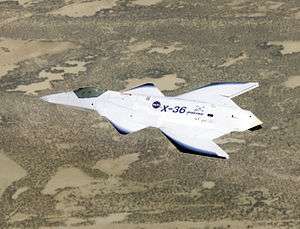McDonnell Douglas X-36
| X-36 | |
|---|---|
 | |
| X-36 in flight | |
| Role | Research aircraft |
| Manufacturer | McDonnell Douglas/Boeing |
| First flight | 17 May 1997 |
| Status | Retired |
| Number built | 2[1] |
|
| |
The McDonnell Douglas (later Boeing) X-36 Tailless Fighter Agility Research Aircraft was a subscale prototype jet designed to fly without the traditional tail assembly found on most aircraft.
Design and development

The X-36 was built to 28% scale of a possible fighter aircraft, and controlled by a pilot in a ground station virtual cockpit with a view provided by a video camera mounted in the "canopy" of the aircraft.
For control, a canard forward of the wing was used as well as split ailerons and an advanced thrust vectoring nozzle for directional control. The X-36 was unstable in both pitch and yaw axes, so an advanced digital fly-by-wire control system was used to provide stability.
First flown on May 17, 1997, it made 31 successful research flights. It handled very well, and the program is reported to have met or exceeded all project goals. McDonnell Douglas merged with Boeing in August 1997 while the test program was in progress; the aircraft is sometimes referred to as the Boeing X-36.
The X-36 possessed high maneuverability that would be ideal for use as a fighter. Despite its potential suitability, and highly successful test program, there have been no reports regarding further development of the X-36 or any derived design as of 2015.
Survivors
- The first X-36 is at the National Museum of the United States Air Force at Wright-Patterson Air Force Base near Dayton, Ohio. It arrived on July 16, 2003, the same day as the Boeing Bird of Prey[2] and is displayed in the Museum's Research & Development Gallery.[3]
- The second X-36 is displayed outside the Air Force Test Flight Center Museum at Edwards Air Force Base in California.
Specifications (X-36)

Data from Designation Systems[4] American X-Vehicles[1]
General characteristics
- Crew: none
- Length: 18 ft 2.5 in (5.55 m)
- Wingspan: 10 ft 4 in (3.15 m)
- Height: 3 ft 1.5 in (0.95 m)
- Max. takeoff weight: 1,250 lb (560 kg)
- Powerplant: 1 × Williams International F112 turbofan , 700 lbf (3.1 kN)
Performance
- Maximum speed: 234 mph (375 km/h)
- Service ceiling: 20,500 ft (6,100 m)
- Thrust/weight: 0.56
See also
- Related developments
- Comparable aircraft
References
- 1 2 Jenkins, Landis, and Miller 2003. p. 46.
- ↑ "Boeing Bird of Prey and X-36 Inducted into Air Force Museum". Boeing, July 16, 2003.
- ↑ "NASA/Boeing X-36". National Museum of the U.S. Air Force.
- ↑ Boeing (McDonnell Douglas) X-36. designation-systems.net, January 9, 2006.
- Jenkins, Dennis R., Tony Landis, and Jay Miller. SP-2003-4531, "American X-Vehicles, An Inventory—X-1 to X-50". NASA, June 2003.
External links
| Wikimedia Commons has media related to McDonnell Douglas X-36. |
- NASA fact sheet on the X-36 Tailless Fighter Agility Research Aircraft
- "X-36 Proving Its Agility In Flight Testing". Boeing, 1997.